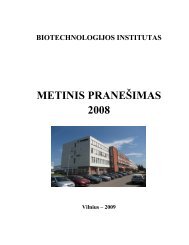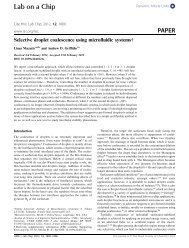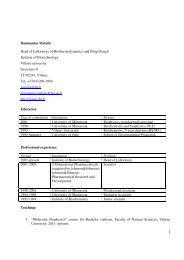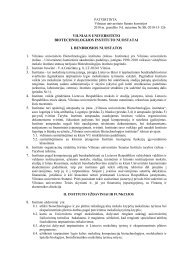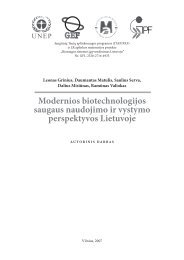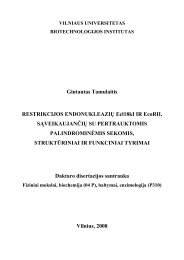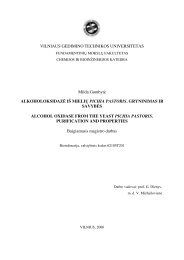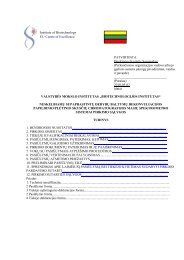Report 2008-2010
Report 2008-2010
Report 2008-2010
You also want an ePaper? Increase the reach of your titles
YUMPU automatically turns print PDFs into web optimized ePapers that Google loves.
HPLC-MS analysis performed by Zita Liutkeviciute<br />
Engineering sequence specificity of DNA methyltransferases<br />
Structure-guided rational protein design combined with random mutagenesis<br />
and selection was used to change the sequence specificity of<br />
the HhaI MTase from GCGC to GCG [3]. The specificity change was<br />
brought about by a five-residue deletion and introduction of two arginine<br />
residues within and nearby one of the target recognizing loops in<br />
the enzyme. DNA protection assays, bisulfite sequencing and enzyme<br />
kinetics showed that the best selected variant is comparable to wildtype<br />
M.HhaI in terms of sequence fidelity and methylation efficiency,<br />
and supersedes the parent enzyme in transalkylation of DNA using<br />
synthetic cofactor analogs. The designed C5-MTase can be used to<br />
produce hemimethylated CpG sites in DNA, which are valuable substrates<br />
for studies of mammalian maintenance MTases.<br />
Engineering the catalytic reaction of methyltransferases for<br />
targeted covalent labeling of biopolymers<br />
G. Lukinavičius, V. Masevičius, G. Urbanavičiūtė, R. Gerasimaitė,<br />
In collaboration with the laboratory of Prof. Elmar Weinhold (RWTH<br />
Aachen, Germany), we synthesized a series of model AdoMet analogs<br />
with sulfonium-bound extended side chains replacing the methyl<br />
group by direct chemical regioselective S-alkylation of AdoHcy and<br />
demonstrated that allylic and propargylic side chains can be efficiently<br />
transferred by DNA MTases with high sequence- and base-specificity<br />
(Dalhoff et al, Nature Chem. Biol., 2006, 2: 31-32; Klimašauskas and<br />
Weinhold, Trends Biotechnol., 2007, 25: 99-104).<br />
Using DNA MTases along with their novel cofactors that carry useful<br />
functional (amino, alkyne, thiol) or reporter (biotin) groups, we<br />
demonstrated that our new approach name mTAG (methyltransferase-directed<br />
Transfer of Activated Groups) can be used for efficient<br />
sequence-specific functionalization and labeling of a wide variety of<br />
model and natural DNA substrates (Lukinavicius et al., J. Amer. Chem.<br />
Soc., 2007, 129: 2758-2759 and in preparation). For example, we have<br />
used mTAG DNA labeling, followed by molecular combing of DNA<br />
onto a polymer-coated surface, to achieve sub-diffraction limit positioning<br />
of the sequence-specifically attached fluorophores in single<br />
DNA molecules (in collaboration with R.K. Neely and J.Hofkens, KU<br />
Leuven, Belgium). The result is a ‘DNA fluorocode’; a linear description<br />
of the DNA sequence that can be read and analyzed like a barcode.<br />
We have demonstrated the generation of a fluorocode for<br />
genomic DNA from the lambda phage virus using M.HhaI [6]. Individual<br />
fluorophores are positioned to within 200 base pairs of their<br />
predicted position on a reference map of the genome. The fluorocode<br />
can be generated from a handful of molecules and entirely independently<br />
of any reference sequence. These findings envision numerous applications<br />
of the new labeling technique in functional studies,<br />
DNA-based nanotechnologies and medical diagnostics. Moreover, we<br />
and our collaborators find that the newly developed cofactors can be<br />
used for targeted transfer of functional groups or other chemical entities<br />
to RNA and proteins using appropriate MTases as catalysts (in<br />
preparation).<br />
Figure 2. Sequence-specific covalent modification of biopolymers (N and X<br />
= nucleotide pairs for DNA and nucleotides for RNA or amino acids for proteins,<br />
XXXXX = recognition sequence of the MTase, X = target nucleotide<br />
(pair) or amino acid) catalyzed by a large number of DNA, RNA or protein<br />
methyltransferase (MTase). Left. Biological methylations involving the<br />
AdoMet cofactor. Right: methyltransferase-direct Transfer of Activated<br />
Groups (mTAG) carrying a reactive or reporter functionality (red sphere)<br />
from a double-activated AdoMet analog onto a target nucleobase in DNA.<br />
Figure 3. ‘DNA fluorocode‘ (illustration from the back cover of Chemical Science,<br />
<strong>2010</strong>, vol. 1, issue 4.). Linear physical positioning of fluorophores (shown<br />
as white elongated vertical ‘bars‘) via sequence-specific methyltransferasedirected<br />
labeling of bacteriophage DNA followed by sub-diffraction resolution<br />
imaging of fluorophores in surface-combed individual DNA molecules.<br />
Such a linear description of the DNA sequence can be read and analyzed like<br />
a barcode [6].<br />
35 th anniversary<br />
24



